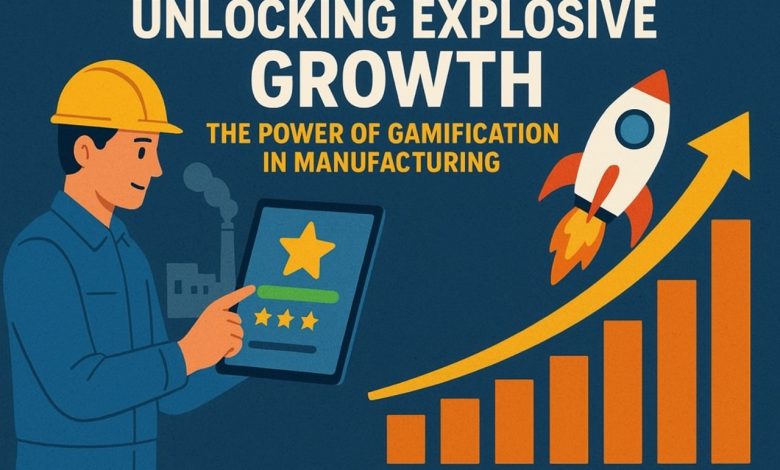Unlocking Explosive Growth: The Power of Gamification in Manufacturing

In today’s fast-paced industrial world, achieving “13x manufacturing growth” may seem ambitious, yet it is entirely possible through the innovative concept of gamification in manufacturing. This blog explores its potential to transform operations by enhancing productivity, engagement, and overall growth.
The importance of such insights is highlighted in HSSMI’s analysis on the future of manufacturing. By integrating game-like elements, such as points, badges, and leaderboards, manufacturers can drive exponential productivity.
Defining and Understanding Gamification in Manufacturing
Gamification refers to “the use of game elements and game-design techniques in non-game contexts.” In the context of gamification in manufacturing, it represents a mindset centered around leveraging psychological and social motivations.
Traditional game elements, such as badges and leaderboards, are integrated to optimize production tasks, enhancing both worker efficiency and engagement. This evolution is further accelerated by technologies like virtual and augmented reality, creating immersive learning environments that move beyond conventional methods.
These gamification tactics for productivity directly influence shop floor efficiency.
Key Strategies for Implementing Gamification
Optimizing Production Throughput
Gamification plays a crucial role in optimizing production processes by offering real-time updates and performance metrics that elevate operational efficiency. These tactics are showcased in Mambo.io’s insights on manufacturing gamification, highlighting streamlined processes and standardized operations.
Standardization and Process Compliance
Consistent procedures are vital for quality products. Gamified recognition systems make compliance a goal rather than a mere requirement, converting adherence into a step toward personal development and workplace success, as explained by Mambo.io’s guidance on enterprise gamification. For a deeper look at effective methods, explore the benefits of gamification in learning and development.
Safety and Preventive Maintenance
Gamifying safety procedures can significantly reduce workplace accidents. Interactive safety training modules and challenges reinforce safe behaviors, fostering a proactive culture of safety. This approach is underscored by Mambo.io’s recommendations on safety gamification.
Building Recognition Cultures
A robust recognition system that involves peer-to-peer rewards nurtures team morale and breaks hierarchical barriers. According to Mambo.io’s analysis, multidirectional acknowledgment leads to a more inclusive and motivating environment.
Throughout these strategies, digital transformation and gamification combine to modernize workflows and operations, as further detailed in our guide on implementing gamification strategies.
Benefits of Gamification in Manufacturing Operations
Enhanced Employee Engagement and Motivation
Gamification significantly boosts employee motivation; Colossyan’s article on gamification in the workplace notes that 89% of people find gamified tasks more motivating. Heightened motivation leads to remarkable improvements in operational performance.
Improved Learning Outcomes and Technical Competence
Gamified training fosters skill development and knowledge retention. Stratbeans’ real-world training examples show how gamification in training boosts technical competence more effectively than traditional methods. Visit our Gamification of Learning resource for more insights. For broader perspectives, explore how gamification can help a business grow.
Reduced Workplace Accidents and Increased Compliance
Interactive safety challenges enhance accountability and compliance, significantly reducing accidents. Strategic gamification approaches make compliance feel rewarding, a point emphasized by Stratbeans’ industry experiences.
Enhanced Operational Efficiency
Real-time monitoring and recognition systems foster stable throughput and smooth operations with minimal disruptions. This advantage is underscored by Mambo.io’s expertise.
Increased Employee Advocacy and Retention
When employees feel valued, advocacy and retention rise, strengthening recruitment and workplace culture. Colossyan highlights the positive relationship between gamification and elevated employee satisfaction.
Gamification Tactics for Productivity Enhancement
Leaderboards and Competitive Challenges
Friendly competition encourages higher departmental output. Real-time rankings drive both individual and collective motivation, as noted by Colossyan’s findings. Delve deeper into effective gamification in corporate learning strategies for further insights.
Real-Time Progress Visibility
Transparent metrics connect workers’ efforts to broader goals, creating alignment and clarity. Mambo.io’s approach to real-time performance tracking demonstrates how workers stay engaged and informed.
Multi-Tiered Recognition Systems
Recognition through badges and peer acknowledgment appeals to diverse motivators. Mambo.io’s research indicates that layered reward systems build employee loyalty.
Integration with Learning Management Systems
Gamified simulations in learning platforms promote skill progression, illustrated by Stratbeans’ real-world training examples. For added perspective, see our comparison of gamification vs game-based learning.
Cultural and Business Performance Impact
Embedding gamification throughout manufacturing fosters open communication, higher workforce satisfaction, and reduced turnover. HSSMI’s insights emphasize how manufacturing gamification strategies continuously support growth and sharpen competitive advantage.
Strategic Implementation Considerations
Effective implementation requires that gamification align with overarching business objectives, balancing competition with collaboration. Continuous refinement based on feedback is critical. Industry guidance from HSSMI, Mambo.io, and Stratbeans can shape a strategic plan.
Conclusion
In summary, gamification in manufacturing offers significant leverage for achieving 13x growth by enhancing engagement, safety, and process adherence. These gamification tactics for productivity provide intrinsic motivation to reshape the future of the sector. By adopting a structured strategy, manufacturers can harness gamification’s potential for enduring cultural and financial success.
FAQs:
How does gamification lead to 13x manufacturing growth?
By integrating game elements into day-to-day operations—such as goal-oriented leaderboards, badges for achievements, and real-time analytics—organizations foster engagement and boost efficiency. This heightened productivity can help deliver higher returns and notable growth.
What are the common gamification elements used in manufacturing?
Popular elements include points-based systems, leaderboards, badges or awards for milestones, real-time performance tracking, and interactive training activities. These elements resonate with workers’ intrinsic motivations and encourage continuous improvement.
How can safety be improved with gamification?
By transforming safety protocols into interactive challenges, employees become more aware of their responsibilities and potential hazards. Gamified modules reward adherence to safety standards, thereby fostering a proactive culture that significantly reduces accidents.



